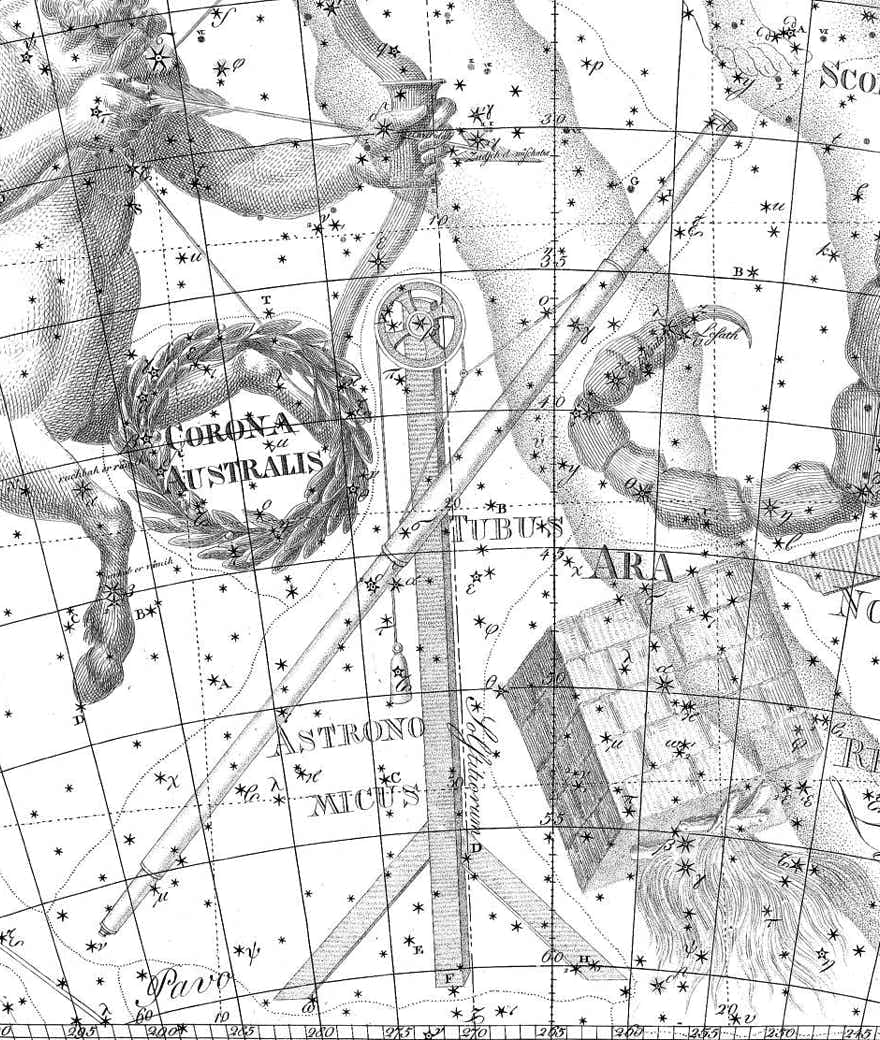
Genitive: Telescopii
Abbreviation: Tel
Size ranking: 57th
Origin: The 14 southern constellations of Nicolas Louis de Lacaille
One of the faint and obscure constellations of the southern sky introduced by the Frenchman Nicolas Louis de Lacaille after his sky-mapping trip to the Cape of Good Hope in 1751–52. It was originally called le Telescope on Lacaille’s first planisphere published in 1756 but was Latinized to Telescopium on the second edition of 1763.
As described by Lacaille, Telescopium represents the type of long, unwieldy refractor suspended from a pole known as an aerial telescope, as used by J. D. Cassini at Paris Observatory. The reason for the great length was to reduce chromatic aberration (false colour) produced by the crude lenses of that time.
Lacaille originally depicted Telescopium as extending northwards between Sagittarius and Scorpius, as shown on the accompanying illustration by Johann Bode, but modern astronomers have cut off the top of the telescope’s tube and mounting so that it is now restricted to a rectangular area of sky south of Sagittarius and Corona Australis. Francis Baily was the first to crop it back in his British Association Catalogue of 1845 by allocating some of its stars to neighbouring constellations, and it was first shown in its current rectangular shape by Benjamin Gould on Chart 7 of his Uranometria Argentina atlas of 1877.
As a result of these revisions, Lacaille’s Beta Telescopii, positioned in the pulley at the top of the mast, is now Eta Sagittarii; Gamma Telescopii, in the upper part of the refractor’s tube, is G Scorpii; and Lacaille’s Theta Telescopii, which marked the telescope’s objective lens, is humble 45 Ophiuchi (also known as d Ophiuchi). See here for a modern chart of this area. Its brightest star, Alpha Telescopii, is magnitude 3.5.
Telescopium, shown under the name Tubus Astronomicus on Chart XV of the Uranographia by Johann Bode (1801), was envisaged as a long-tubed refractor operated by ropes and pulleys and balanced by a counterweight. Click here for Lacaille’s original depiction.
© Ian Ridpath. All rights reserved
Lacaille described Telescopium as ‘la grande lunette astronomique’, suspended from a mast, in the notes to his preliminary catalogue and chart published in the Histoire de l'Académie royale des sciences in 1756. He initially gave it the French name Le Télescope, but this was Latinized to Telescopium on his revised catalogue and chart of 1763.




